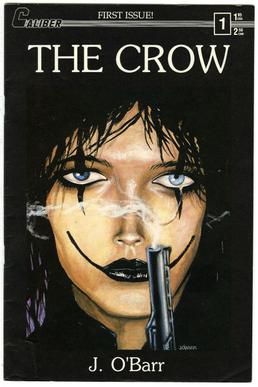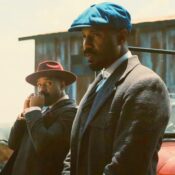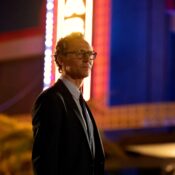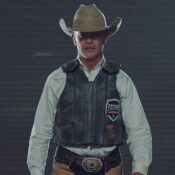
Arriving in theaters before the decline of the first Batman film franchise and weeks after the death of Kurt Cobain, Alex Proyas’s The Crow, based on the independent comic by James O’Barr, managed to have a lasting impact on film, comics, music, and the soul of a generation. Steeped in a sense of loss that was magnified when leading man Brandon Lee was killed during filming, The Crow emerged as a cultural touchstone due to all of the forces contained in its 102-minute runtime. Now, 25 years later, we look back at why so many pieces of the work still resonate.
1. It’s Personal
A central theme of The Crow is loss, and that comes from a very honest place. O’Barr started working on the story after losing his fiancée to a drunk driver. That tragedy, along with a local news story about a young couple murdered for an inexpensive engagement ring, provided the fuel to O’Barr’s tale of Eric Draven, a man who comes back from the dead to avenge the loss of his own fiancée; the title comes from the supernatural guide that accompanies Draven on his quest.
2. Brandon Lee’s Unfortunate Passing Added a Deeper Layer
Brandon Lee had been a working actor with a cult following for several years when he took on The Crow. The son of film and martial arts legend Bruce Lee, Brandon Lee grew up learning Kung Fu and had expressed an interest in acting before his father’s death in 1973. The younger Lee made his acting debut in the television sequel to the Kung Fu TV series in 1986, and soon after moved to major studio action films. His casting in The Crow was considered big entertainment news at the time.
On March 31, 1993, with three days left to film, Lee was killed in an on-set accident. Ironically, this occurred during the scene in which his character is killed prior to his supernatural resurrection. Lee died after being shot with an improperly prepared prop gun; the revolver still had a dummy bullet lodged in the chamber, and the discharge of the loaded blank provided enough force to fire as if it were a live round. Lee was struck in the stomach and died after six hours of surgery.
In another unfortunate coincidence, Lee had been engaged to be married to Eliza Hutton, who also worked in the film industry, the week after completing the film. Hutton, along with Lee’s mother, Linda Lee Cadwell, supported director Proyas in his effort to complete the movie. Using a combination of stand-ins and nascent digital effects, Proyas completed scenes and edited the film in way to make the process seamless.
Lee’s tragic death drew wider attention to the film and propelled interest in it. The studio Dimension Films, which at the time was the genre label within Miramax, marketed it aggressively. The movie would open at #1 at the box office in the United States while receiving solid reviews. While the atmosphere, action, and music were widely praised, a number of critics offered raves about Lee himself. In particular, Roger Ebert wrote, “It is a sad irony that this film is not only the best thing he accomplished, but is actually more of a screen achievement than any of the films of his father, Bruce Lee.”
3. Alex Proyas Brought the Style
The recently resurrected Eric’s memories of Shelly drive him to revenge; the music is “Burn” by The Cure. (Uploaded to YouTube by Movieclips)
The pages of O’Barr’s comic are steeped in Gothic style. The black and white book relies heavily on the shadows and sharp angles of German horror films and film noir. The striking look of the lead character’s make-up (which leads one film character to refer to him as “a mime from hell”) is amplified by lyrical passages from bands like Joy Division and The Cure that O’Barr quotes throughout. The visual achievement that director Alex Proyas essays is a very direct transposition of this atmosphere from the page to screen. The Crow was only the director’s second feature; his first film, Spirits of the Air, Gremlins of the Clouds had been nominated for two AFI Awards and took the Special Prize at Yubari International Fantastic Film Festival in Japan.
In The Crow, Proyas not only echoed the look of the comic, but also employed other innovations. He occasionally used distorted lensing to capture scenes from the point of view of the titular bird. Proyas also used unusual lighting, such as one scene in a bathroom that’s illuminated only by the lights over the mirror; those choices play into the dark-and-shadow visual aesthetic of the original while doing something different with the scene. The action and music-performance scenes remain top-notch as well.
4. The Music Mattered
“Time Baby III” by Medicine (Uploaded to YouTube by Medicine / Atlantic Records)
The mid-90s saw seismic shifts in music. Among the most important movements was the ascent of alternative rock, fueled in part by the breakthrough of the Seattle bands like Nirvana and Pearl Jam in 1991. The overall style played to alienated youth, which was exactly the kind of audience that had found the original comic. By 1994, dozens of these new acts (like Nine Inch Nails and Stone Temple Pilots) had made deep impressions, while pioneering older acts like The Cure and Joy Division were being rediscovered. O’Barr’s own taste in music lined up with this new soundscape, and Proyas recognized that. The soundtrack of the film brought in a number of of-the-moment acts and veterans, including The Cure themselves. Nine Inch Nails covered “Dead Souls” by Joy Division, which was referenced in the original comic. Other acts included Pantera, Stone Temple Pilots, the Jesus and Mary Chain, Rage Against the Machine, Violent Femmes, and Jane Siberry. Medicine and My Life with the Thrill Kill Kult both appear in the film, performing their songs from the soundtrack.
The 14-song album hit #1 on the Billboard album chart, selling nearly four million copies. The Stone Temple Pilots song “Big Empty” was released off of the soundtrack as a single; it hit the top ten of both the Mainstream and Modern Rock charts. A second album, featuring the instrumental score written by celebrated composer Graeme Revell, was released; it includes “Inferno,” the rooftop guitar solo played by Lee’s character in the movie.
5. It Was Good
Trailer for The Crow (Uploaded to YouTube by YouTube Movies
There’s a lot to be said for simply making a good movie. The Crow combined a solid roster of talent in terms of the cast (not just Lee, but veteran actors like Ernie Hudson, Michael Wincott, David Patrick Kelly, and Tony Todd, plus an affecting child-actor turn from Rochelle Davis). The director, the musicians behind the soundtrack, and a talented crew, notably in sound, lighting, and stunt work produced great material. The film arrived at precisely the right time, with the music fitting the times. Tim Burton’s darker comic-book work helped paved the way with two prior Batman features in 1989 and 1992. Lee’s death, as well as the then-recent death of Nirvana frontman Kurt Cobain weeks before the film’s release, cast long shadows that played into the melancholy in the air and in the film. Dimension also showed savvy in the marketing of the movie, making large ad buys on MTV and prominently featuring the music in the ads. The film still carries an 81% positive critic score and 90% audience score at review aggregator Rotten Tomatoes, with strong notices coming from outlets like The New Yorker, Variety, and the L.A. Times. TV Guide offered rapturous praise, calling the film “A gorgeous black valentine that captures the essence of adolescent misery, coupled with a wildly romantic vision of the power of pure love to overcome all obstacles — even the grave.” Rolling Stone critic Peter Travers was wowed by Lee, writing “Draven is the rocker as avenging angel, prowling the streets cracking jokes and heads but also capable of expressing great feeling. Lee is sensational on all counts in a final performance that brims over with athleticism and ardor.”
Today, James O’Barr continues to create The Crow in comics, with the most recent series published last year. Three additional Crow films were made in 1996, 2000, and 2005, bracketing a 1998 television series. Director Colin Hardy and actor Jason Momoa were said to be involved in a new film, but both departed the project in 2018. There have also been novels, card games, and a video game. Still, the most iconic version of the character outside the written page continues to be the one brought to (after)life by Brandon Lee. The Crow remains a unique snapshot of its time, creating an effective parable about love and loss. The work deals in some serious darkness, but as Lee’s character himself says, “It can’t rain all the time.”
Become a Saturday Evening Post member and enjoy unlimited access. Subscribe now


